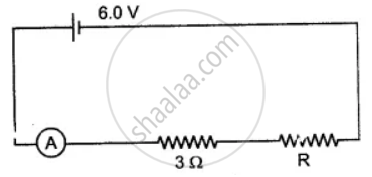Advertisements
Advertisements
Question
A current of 5 amperes flows through a wire whose ends are at a potential difference of 3 volts. Calculate the resistance of the wire.
Solution
Here:
Current, I = 5 A
Potential difference, V = 3 V
Substituting these values in the Ohm's equation, V/I = R:
Resistance of the wire, R = 3/5 = 0.6 Ω
APPEARS IN
RELATED QUESTIONS
What is the SI unit of potential difference?
Name a device that help to measure the potential difference across a conductor.
Calculate the potential difference between the two terminals of a battery if 100 joules of work is required to transfer 20 coulombs of charge from one terminal of the battery to the other.
The differences between the electrostatic potential of the positive end the negative end of an electric cell is the ______ of the cell.
A V-I graph for a nichrome wire is given below. What do you infer from this graph? Draw a labelled circuit diagram to obtain such a graph.

Draw a graph of Potential difference (V) versus Current (I) for an ohmic resistor. How can you find the resistance of the resistor from this graph?
Suppose there are three resistors A, B, and C having resistances r1, r2, and r3 respectively. If R represents their equivalent resistance, establish the following relation `1/"R" = 1/"r"_1 + 1/"r"_2 + 1/"r"_3`, when joined in parallel.
The figure shows a circuit. When the circuit is switched on, the ammeter reads 0.5 A.

(i) Calculate the value of the unknown resistor R.
(ii) Calculate the charge passing through the 3 Ω resistor in 120 s.
(iii) Calculate the power dissipated in the 3 Ω resistor.
Define Electric potential.
______ is work done per unit charge.
